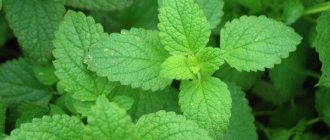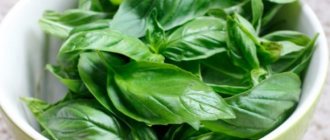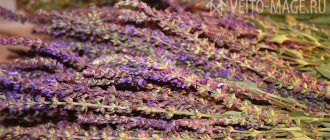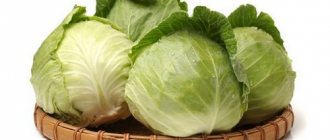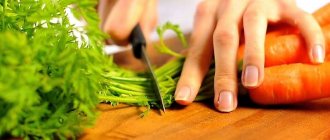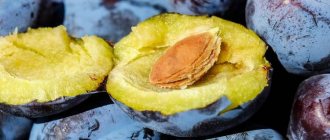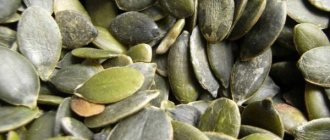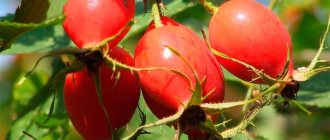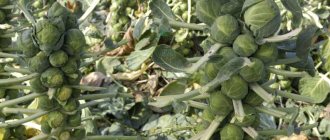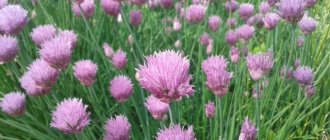In the cold winter, you want not only to warm up, but also to feel the taste and soothing smell of mint.
The question arises when to collect the leaves of this plant and how to dry them correctly. Dear readers!
For you, we have created communities on social networks in which useful articles and interesting ideas are published several times a day! Subscribe and receive useful content in a convenient format! There is nothing overly complicated in this whole procedure, but without the appropriate experience it is easy to make mistakes.
In today's article we will talk about the timing of collecting mint for the winter and methods for drying it.
Which mint is suitable for drying?
Not every plant is suitable for drying for the winter. It doesn’t matter what variety of mint you choose, but you’ll have to think about the specific plant.
First, collect mature, succulent specimens.
Secondly, do not pick mint that is too young. Such specimens will dry out quickly.
Naturally, you cannot take grass near roads, enterprises, landfills, etc. A lot of waste and toxins accumulate in the tissues of such plants. Instead of benefit, such a plant will only bring harm.
Fragrant sugar from fresh mint
Another way to keep mint fresh for the winter will appeal to all sweet tooth lovers. Aromatic sugar based on selected mint greens is suitable for preparing a wide variety of culinary dishes; it can be added to baked goods, drinks, fruit salads and desserts. At the same time, the sweetness takes on all the beneficial properties of the plant, and the mint is kept fresh for the winter.
For 200 grams of chopped mint, take the same amount of sugar. The ingredients are thoroughly crushed and mixed in a blender until smooth, and then placed in dry, clean jars, simultaneously compacting the sugar.
Sugar with mint can be stored in the refrigerator for quite a long time, and in order for food to acquire the real aroma of this fragrant plant, it should be added to the finished dish.
When to collect mint for drying for the winter
Harvest this variety of spicy greens in the last days of July - the first ten days of August. At this time, the greens contain the maximum concentration of essential oils and extract. And that means it is more useful.
ON A NOTE.
The leaves are not torn off, but carefully cut with scissors or a sharp knife. This way you will avoid damaging the remaining stems of the plant. Also, don't cut too close to the ground. Otherwise, the plant will not produce new leaves.
Carefully place the collected mint in a bag. No need to crumple the leaves. Damage to leaf tissue affects taste and shelf life.
Also cut so as to capture the petiole along with the leaf. Then the leaves will be tied together by their petioles into one bunch for drying.
It is advisable to prepare leaves before noon. The ideal time is when the dew has already passed and the sun has not yet reached its zenith.
By the way, it is believed that the best time to collect greenery is during flowering.
Where does mint grow, what does it look like?
Mint is a representative of the genus of perennial herbaceous plants of the Lamiaceae family.
The distribution area is quite wide throughout the world. Mint grows in European and Asian countries, Africa and North America. It is successfully grown on moist soils in Russia, Belarus, and Ukraine. Mint is a perennial plant that reproduces through underground rhizomes. If left unchecked, it can become a nasty weed and take over the entire garden.
Mint grows best in shady areas in fertile, moist soil. All its species have a four-sided stem and ordinary paired leaves. The leaves are about 5 cm long, bright green, elongated or pointed, veined and jagged on the sides.
The plant does not branch, and grows densely in damp places along roads, near rivers, in meadows and pastures, where it reaches a height of 60-90 cm. The inflorescences are grouped at the top of the stem, their shape is directed upward. The flowers are pale to dark purple and bloom in July and August. The small tubular flowers have two long and two short stamens. The seeds are small, round and brown.
How to prepare mint for drying
Let’s say right away that the time interval between collecting the leaves and starting to dry them should not exceed 2 hours.
The first thing to do with the collected mint is to sort the leaves. We throw away leaves that are too old and withered. At the same stage, we discard randomly encountered weeds.
Next, you need to rinse the mint.
How to dry mint correctly, what you can and cannot do
The leaves are dried exactly until they begin to rustle when touched and break. If the leaves are wrinkled, then drying is not yet complete.
It is possible and even advisable to periodically gently stir the leaves so that they dry on both sides.
It is not advisable to turn on the appliances in use at their maximum power. This way the procedure will take less time, but the mint may dry out and lose both its aroma and the beneficial properties for which it is valued.
Do not dry out the mint. This makes it brittle, turns into powder, partially loses its unique aroma and almost completely its beneficial properties.
Is accelerated drying acceptable?
Vegetables and fruits prepared for the winter are often dried at home in ovens or electric dryers, which these days can be purchased at almost any electrical goods store. But is it possible to dry herbs and, in particular, mint in this way?
In principle, it is possible, but only under one condition: if you ensure the temperature is no higher than 30 degrees. Higher readings on the thermometer will “kill” the taste, aroma and medicinal properties of the plant.
Since mint is collected mainly from the end of July to the end of August, the necessary temperature conditions for drying it are already provided by nature. So conditionally accelerated drying justifies itself only in rainy summers.
How to air dry mint
The easiest and most affordable option to dry mint is to carry out the procedure naturally in the air without the use of any additional equipment.
Freshly harvested plants need to be dried in this way. This is how everything for which we value mint will be preserved as much as possible: aroma, taste, benefits.
Drying is carried out according to the following algorithm:
- We distribute the leaves according to size and divide them into bunches;
- we tie the bundles by the stems with thread or twine;
- we hang the collected bunches by the petioles;
- leave the bunches until completely dry (takes from 1 to 3 weeks depending on the weather outside);
- transfer the dried mint to a container for later storage.
IMPORTANT!
Leaves should be dried in a dry, ventilated place with low humidity and no direct sunlight.
This method is the most affordable, because it does not require additional equipment. You can even dry mint at home in the kitchen cabinet or on the balcony. An additional benefit of natural drying is the minty aroma.
Of course, this method is not without its drawbacks. For example, it will not be possible to dry the product if the weather outside is cloudy or even rainy.
When and what plants to collect for mint tea
Depending on the region where it grows, mint begins to bloom in June-July. It is at this time that all parts of the plant are most saturated with essential oils. Moreover, there are approximately twice as many of them in the inflorescences as in the leaves. And when the plant is in full bloom, its aromatic properties are at their maximum.
Closer to the inflorescence, the leaves are more tender and aromatic
However, buds and young shoots may appear later. You can also harvest a small “harvest” from them to make tea.
Cut off for drying:
- Whole shoots.
- Separately leaves.
- Separately inflorescences.
Just as different varieties of black and green tea are obtained by plucking the leaves of the tea bush at different levels of the shoots, the same is true with mint. But this is even convenient: when brewing different parts of the plant, you get tea of different richness.
Not only the month of mint collection is important, but also the time of day and weather conditions.
As with other herbs, the correct weather for harvesting is dry, and the time of day is morning or evening.
The main thing is that there is no dew.
You should not water the plant before harvesting. If the greens are dusty, you need to wash off the dust with a hose or watering can the day before. Then cut off the greens when completely dry. When collected wet, the raw material darkens. It is impossible to obtain high-quality tea preparations from such raw materials.
You should not collect or dry mint that grows along roads, busy highways, or near areas where animals and birds are kept.
Best places to gather
The best mint grows in loose, fertile soil with sufficient moisture and sunlight. A large number of shoots gives 2-3 years of life. It is better to uproot bushes older than 5 years and plant new ones in another place.
It is worth collecting it on your own site or from well-known territory, where heavy feeding with fertilizers and treatment with chemicals is excluded. Since plants absorb various harmful impurities from the external environment well, those that grew near contaminated areas are not suitable for further harvesting:
- technical or agricultural complex;
- garbage dumps;
- frequently used road (closer than 200 m).
How to use an electric dryer
You are lucky if you have an electric dryer, which is used to obtain dried fruits. Then the greens can be dried in it.
The leaves are laid out on a wire rack in 1 layer. Turn on the device to the minimum temperature.
Of course, drying will take longer this way, but the maximum beneficial properties of mint will be preserved.
Check the grass periodically to make sure it doesn't dry out.
After completing the procedure, transfer the dried product to the selected container.
How to use a microwave for drying
The most exotic method is drying the leaves in the microwave.
Place the leaves in a single layer on a plate and microwave. Set the timer for 10 seconds (less is possible) and dry the mint.
Such a short period of time will allow you to control the degree of drying of the leaves and avoid drying out of the mint.
The approximate time until fully cooked is from 15 to 45 seconds.
ON A NOTE.
Exactly how long drying will take depends on the number of leaves, their quality, and the power of the microwave oven.
How to store dried mint
In order for dried green leaves to be used for as long as possible, they must be stored properly.
Use glass vials or plastic containers to store dried mint. To prevent the mint flavor from fading away, select containers with a tight-fitting lid.
When transferring the product into selected jars, try not to break the leaves. When whole, they better retain their beneficial properties. If you need powder, grind it immediately before using it for its intended purpose.
The bottles themselves should be stored in a dry place away from the sun. A kitchen cabinet is perfect for this purpose.
Check from time to time to see if the spice needs to dry out a little more. There's nothing wrong with that. It is difficult to constantly maintain low humidity even in an apartment.
Therefore, sometimes you may have to dry the mint again. In this case, use the same method you used in the beginning.
Harvesting mint on an industrial scale
On plantations, various devices are used for harvesting. Special harvesters cut off the top part of mint bushes. After 2-3 days, the dried grass is placed in containers. The problem of how to dry mint is solved using drying machines with a centrifuge, blowing, and a dehydrating mechanism.
The mint dried in this way is crushed and then sent for packaging or processing. It is mainly used in the manufacture of medicines and pharmaceutical preparations.
Dried mint can be stored crushed or in bunches.
Common mistakes
Let's look at what mistakes are made when drying and storing mint.
- Drying too quickly.
When using an oven, electric dryer or microwave, it is tempting to set the power to maximum so that drying is completed faster. But you can’t do this, because then the mint will lose its taste, aroma and beneficial properties. - Poor drying.
To prevent rotting processes from starting, the greens must be thoroughly dried. Take your time. Let the procedure take extra time, then the product will deteriorate later. - Mint leaves break when dried or when poured into containers.
This is how dried herbs lose their aroma faster. - A container of mint is stored in the sun.
Similar to the previous point, storage in the sun harms the beneficial properties of the dried plant.
Use of dried mint, beneficial properties
The workpiece is not soaked before use. Dried raw materials - independent brewing. Often mixed with other types of tea. In cooking they are used to prepare compotes, smoothies, and sauces.
Dried mint leaves retain up to 3% essential oils. The product contains vitamins B1, B2, B9, B5, PP, A, C. Flavonoids, tannins, organic acids, fiber, and sterols are present. The mineral composition cannot be called poor either. Potassium, calcium, copper, iron, zinc, phosphorus benefit the human body. But mint is most valued for its menthol. The concentration depends on which variety was used. The time of collection is affected.
Beneficial properties of dried mint leaves:
- relieves headaches, relieves migraines;
- helps cope with heartburn, nausea;
- has a calming effect, normalizes sleep;
- treats runny nose, cough, makes breathing easier;
- reduces blood pressure;
- reduces menstrual pain;
- lowers temperature, relieves fever, often combined with raspberry leaf, lemon, other herbs, fruits;
- relieves sore throat, used to treat sore throat;
- cleanses the blood;
- gently eliminates diarrhea, normalizes intestinal function.
Features of using dried mint
The product has a positive effect on the skin - it reduces inflammation, normalizes sebum production, refreshes and tones. Mint infusions are used to rinse hair and treat dandruff. They are often used instead of water in home masks, hand and foot baths.
There's a reason toothpastes have a menthol flavor. This substance has a positive effect on enamel and gums, prevents caries, and at the same time freshens breath.
Answers to frequently asked questions
How can you tell if mint is well dried?
Properly dried leaves retain their natural shade and rustle pleasantly in your hands without turning into dust.
How long does dried mint last?
Without loss of beneficial properties and aroma, mint can be stored for a year.
Who shouldn't drink mint tea?
With caution: persons who are allergic to this herb, people with low blood pressure and problems with blood vessels, gastrointestinal tract, as well as children.
What is the best way to store mint?
Ideally in special glass spice jars or canvas bags. Storage in wooden and plastic containers with a tight lid is allowed.
Can it be stored in plastic bags?
It is not advisable to store dried product in bags. Instead of plastic, it is better to use paper or canvas bags.
Contraindications
It is not recommended to indulge in mint teas:
- hypotensive patients;
- patients with severe liver damage;
- persons suffering from varicose veins;
- people who have low acidity of gastric juice and are prone to heartburn;
- children under 3 years of age;
- pregnant women and nursing mothers;
- men with libido problems;
- women with difficulties conceiving;
- for allergy sufferers and people suffering from individual intolerance.
The substances contained in mint have a calming effect. It is important to know about this for patients using medications with similar effects, as well as for people whose work requires increased concentration and quick decision-making.
